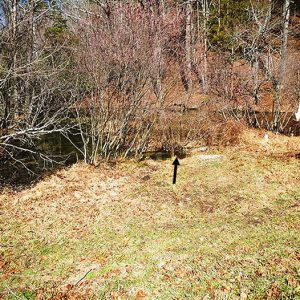calsfoundation@cals.org
Abernathy Spring
Geological Feature
Abernathy Spring is a mineral spring located in Polk County, 2.8 km (1.75 mi.) east of the unincorporated community of Big Fork on the north side of State Highway 8. Elevation is 335 meters (1,099 ft.). The spring was owned by Rufus J. Abernathy (1856–1932), who resided at Big Fork and is buried at the Pleasant Grove Cemetery just outside of town and east of the spring. Water from the spring drains into adjacent Big Fork Creek (a tributary of the Ouachita River) and, at one time, was used for domestic purposes, such as for water supply and to keep food cold. There are actually two springs at this location—the primary one is a 75 cm (29.5 in.) diameter galvanized steel-reinforced opening (at one time, it was a wooden box), and the other is about six meters (20 ft.) away but is difficult to discern.
An unpublished compilation of information on springs in Arkansas collected during the late nineteenth and early twentieth centuries provided some information on Abernathy Spring. Water chemistry was recorded, and the main constituent was iron (ferrous) carbonate (FeCO3) in addition to lime (calcium) carbonate (CaCO3), magnesium carbonate (MgCO3), sodium chloride (NaCl), and potassium chloride (KCl), with small quantities of organic matter, carbonic acid (H2CO3), and silica (SiO2). The water was odorless with a temperature of 10°C (50°F) with a neutral pH, and total dissolved solids were 162 milligrams/3.4 liters (2.5 grains/gallon). Drinking-water standards recommend that waters containing more than 500 mg/l dissolved solids not be used if other less-mineralized supplies were available, and so this spring was potable at that time. Flow rate was reported to be 0.16 to 0.29 cubic feet per second (70 to 130 gallons/hour). Physicochemical conditions obtained sometime in the 1980s were as follows: water temperature averages about 16°C (61°F), pH 7.0, conductivity of 144 ohms, and alkalinity of 70 mg/1 CaCo3. On January 28, 2018, the air temperature was 12°C (53°F), and select physicochemical conditions were as follows: water was odorless, water temperature was 16°C, pH 6.4, hardness of 0 ppm, and alkalinity of 100 mg/l CaCo3.
The surface geology in the area is closely folded ridges and valleys of Ordovician and Silurian sandstone and shale. In addition, Arkansas novaculite is exposed along the outer edge of the Central Ouachitas, known as the Novaculite Uplift. The novaculite is very hard, fine-grained rock of silica once used by natives and others as an abrasive stone and as a silica source in modern manufacturing. Soils are mainly silty clay and silty loam, deep in the valleys and very rocky on the ridge tops.
In and around Abernathy Spring is a mixture of pines (Pinus spp.) and upland hardwood forest including white oak (Quercus alba), black oak (Q. velutina), and southern red oak (Q. falcata) together with mockernut hickory (Carya tomentosa) and shagbark hickory (C. ovata).
Concerning biota of this spring, the endemic Abernathy Spring isopod (Caecidotea fonticulus), which is the first phreatobite (a troglomorphic species restricted to the phreatic zone) asellid isopod from the Ouachitas, was described in 1983 from this unique spring and occurs nowhere else on Earth. It is listed as a critically imperiled (S1) species in the state according to NatureServe.
For additional information:
Branner, G. C. Data of Springs in Arkansas. Little Rock: State of Arkansas, Arkansas Geological Survey, 1937.
Graening, G. O., Michael E. Slay, Danté B. Fenolio, and Henry W. Robison. “Annotated Checklist of the Isopods (Subphylum Crustacea: Class Malacostraca) of Arkansas and Oklahoma, with Emphasis Upon Subterranean Habitats.” Proceedings of the Oklahoma Academy of Science 87 (2007): 1–14.
Lewis, Julian J. “Caecidotea fonticulus, the First Troglobitic Asellid from the Ouachita Mountains (Crustacea: Isopoda: Asellidae).” Proceedings of the Biological Society of Washington 96 (1983): 149–153.
Robison, Henry W., and Robert T. Allen. Only in Arkansas: A Study of the Endemic Plants and Animals of the State. Fayetteville: University of Arkansas Press, 1995.
Chris T. McAllister
Eastern Oklahoma State College
 Geography and Geology
Geography and Geology Abernathy Spring
Abernathy Spring  Abernathy Spring
Abernathy Spring  Polk County Map
Polk County Map 




Comments
No comments on this entry yet.